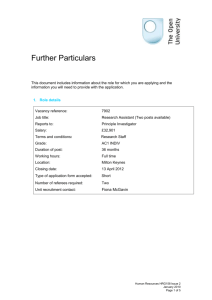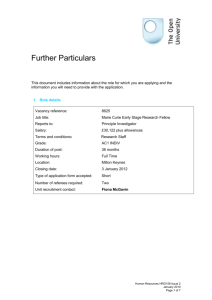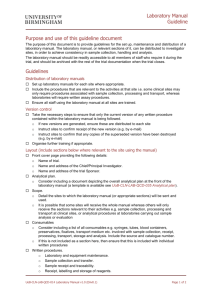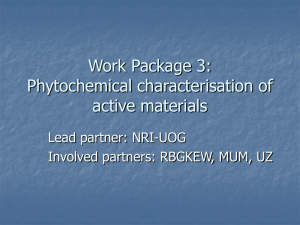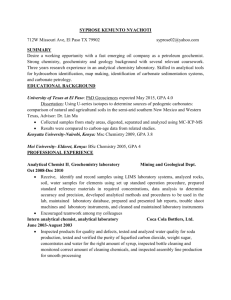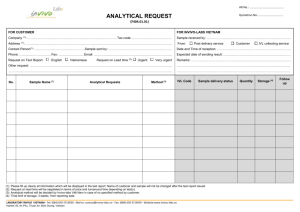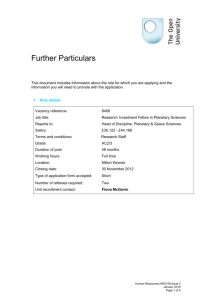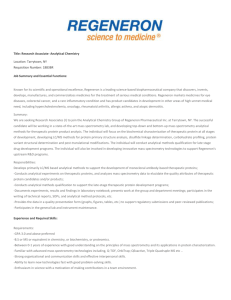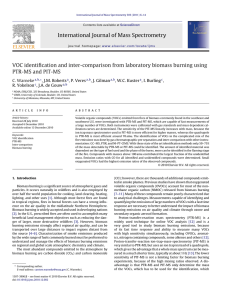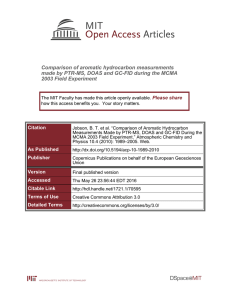Further Particulars HRG158
advertisement
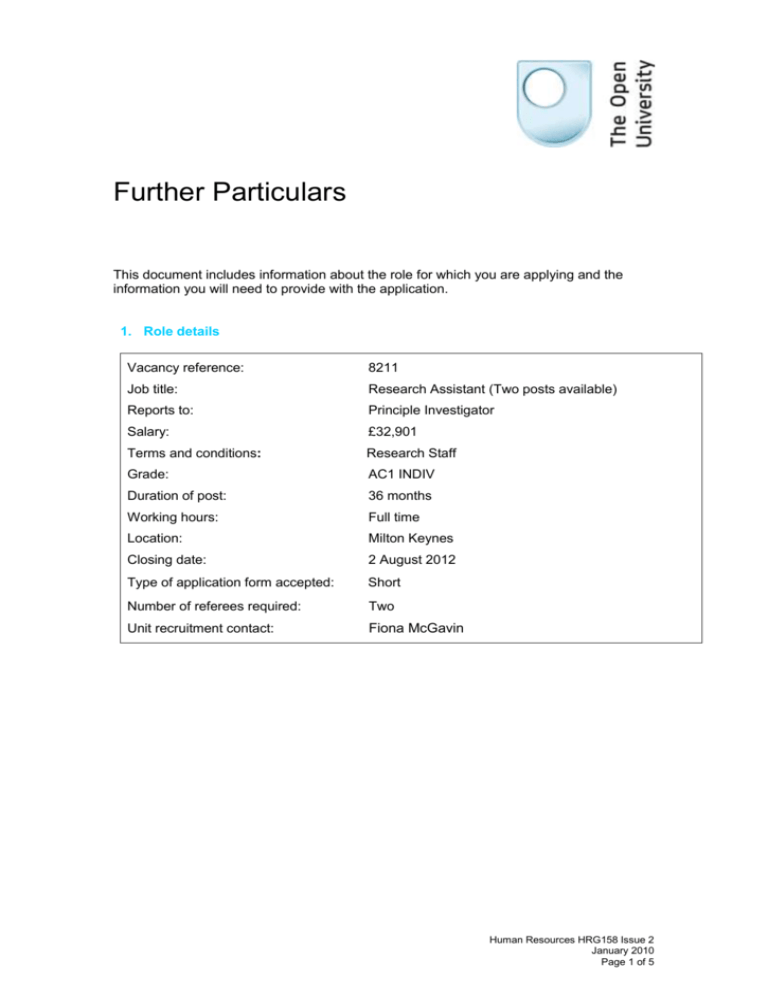
Further Particulars This document includes information about the role for which you are applying and the information you will need to provide with the application. 1. Role details Vacancy reference: 8211 Job title: Research Assistant (Two posts available) Reports to: Principle Investigator Salary: £32,901 Terms and conditions: Research Staff Grade: AC1 INDIV Duration of post: 36 months Working hours: Full time Location: Milton Keynes Closing date: 2 August 2012 Type of application form accepted: Short Number of referees required: Two Unit recruitment contact: Fiona McGavin Human Resources HRG158 Issue 2 January 2010 Page 1 of 5 2. Summary of duties Two posts are available from October 2012 onwards for 36 months to work in the field of threat agent detection as part of the Marie Curie Initial Training Network (ITN) Proton Ionisation Molecular Mass Spectrometry (PIMMS) funded by the European Commission. PIMMS is a multidisciplinary and intersectoral analytical chemistry ITN with the objective to train 15 Early Stage Researchers (ESR) within a collaborative academic and commercial challenging analytical research network involving 12 full-partners and four associate partners, and with the aim of delivering research through five interlinking themes: Fundamental Research and Development; Food Sciences, Environmental Sciences, Health Sciences, and Homeland Security. The research training is focused on the conduct of internationally leading analytical research projects which, whilst centred upon the development and adoption of Proton Transfer Reaction Mass Spectrometry (PTR-MS) as an analytical tool, will provide training across a wide variety of analytical technologies that are complementary to PTR-MS, thereby providing a broad interdisciplinary and intersectoral experience in analytical chemistry. The main objective of the project at The Open University is to develop PIMMS as an analytical tool and to exploit PTR-MS in health sciences and environmental studies. You will be interviewed against one of two projects: Project 1: Fundamental and Applications of Proton Transfer Reactions using SIFT and IMS-MS systems This project encompasses developing the PTR-MS technique for its use in the analysis of medically important volatile organic compounds (VOCs) by investigating their reactions with hydronium ions in both PTR-MS and SIFT-MS. Project 2: Emissions of biogenic VOCs, methane and N2O from plants under a changing atmospheric composition There is an increasing demand to develop analytical instruments to explore biogenic emissions as markers for specific stress conditions of plants that mimic the effects of climatic change and an anthropogenically altered tropospheric chemistry. In this project the detection of VOC emissions and methane from plants (e.g. rice and tree saplings) will be explored both in the field and within controlled environments in the laboratory. Other duties All staff are expected to: Comply with the University’s Health and Safety and Equal Opportunities policies in the performance of their duties. Take reasonable care of the Health and Safety of themselves and that of any other person who may be affected by their acts or omissions at work. Co-operate with the Open University in ensuring as far as is necessary, that Statutory Requirements, Codes of Practice, University Policies and Departmental Health and Safety arrangements are complied with. Have a strong commitment to the principles and practice of equality and diversity. Attend appropriate staff development events. Human Resources HRG158 Issue 2 January 2010 Page 2 of 5 3. Person specification Essential criteria A Master degree in the field of physics, chemistry, engineering, or any other related fields acquired not more than 4 years before the starting date Good knowledge of English as you will be expected to submit project reports in English. 4. Role specific requirements e.g. Shift working The post holders will register for a PhD with The Open University and will have the opportunity to undertake training and experiments at other sites within the EU Training Network. The Fellowship covers monthly salary for three years and other allowances in line with FP7PEOPLE-2011-ITN. The gross annual salary is at a fixed rate as specified in Section 1. For more information: http://ec.europa.eu/research/fp7/understanding/mariecurieinbrief/home_en.html The Post is offered in the context of a Marie Curie Initial Training Network and transnational mobility is a key element of eligibility. As such, applications will only be accepted from candidates who have spent less than 12 months in the UK within the last three years. Candidates’ eligibility for the post is determined by Marie Curie terms and conditions. 5. About the unit/department Faculty of Science The Faculty has a staff of about 310, comprising of around 115 academic staff (central and regional/national) with the balance made up of research staff, curriculum managers, laboratory staff, administrators and clerical staff. There are also varying numbers of research students and visiting academic staff. The Faculty has three departments, each with constituent discipline groups: Department of Environment, Earth and Ecosystems Earth Sciences Ecosystems and Biodiversity Department of Life, Health and Chemical Sciences Brain & Behavioural Sciences Cell & Molecular Biology Chemistry & Analytical Sciences Human Biology Department of Physical Sciences Astronomy Physics Planetary & Space Sciences Science Curriculum Human Resources HRG158 Issue 2 January 2010 Page 3 of 5 The Faculty currently supports a broad-based Natural Sciences programme. Within this there are 5 undergraduate discipline-based pathways; Life Sciences, Health Sciences, Chemistry and Analytical Science, earth and environmental sciences, and Physical Science. At post-graduate level, the Faculty supports an MSc programme which currently has several strands including Science Studies, Earth Science, Frontiers in Medical Science, and Health Physics. The Faculty also supports foundation degrees in Health Sciences (including paramedic and operating theatre practice) and Analytical Science. eSTEeM (http://www.open.ac.uk/about/teaching-and-learning/esteem/ ) is an initiative to bring together academics within Science and the Faculty of Maths, Computing and Technology to develop new approaches to teaching and learning. This centre builds on existing collaborations developed within the Centres for Excellence in Teaching and Learning (CETLs) based at the OU and with other Faculties, aiming to embed new approaches around priority areas such as eassessment, online experimentation, etc. Science Research The Faculty’s research addressed the major scientific and technological changes of our era including: The causes, effects and mitigation of climate change; The exploration of our solar system and discovery of new worlds in other solar systems; The search for origins of life; The study of the causes and mitigation of a range of diseases; Understanding the aging process; The development of the next generation of technologies including hosting the OU/e2v Centre for Electronic Imaging; e2v being a leading developer and manufacturer of specialist components and sub-systems for the medical, aerospace and defence industries Our research is organised through two major research groupings: The Centre for Earth, Planetary, Space and Astronomical Research (CEPSAR) Biomedical Research Network (BRN) Our research encompasses both 'blue-skies' basic research and applied research to find solutions to specific scientific and technological problems. In addition, the Faculty of Science is supporting a number of new ‘genesis’ areas where new synergies are rapidly developing in response to external research opportunities. We have over 4500 square metres of state-of-the-art research laboratories with major research facilities that include: A facility for interdisciplinary research in ecosystems and geobiology. One of Europe’s leading centres for isotope mass spectrometry including extensive radiogenic, noble gas and stable isotope mass spectrometry facilities and a new £3 million microbeam facility, including a Cameca Nanosims ion imaging system and dual beam FIB-SEM Ultraclean spacecraft instrument testing and assembly, and for handling planetary materials and returned extra-terrestrial samples A state-of-the-art life sciences research facility including biological containment Human Resources HRG158 Issue 2 January 2010 Page 4 of 5 laboratories, molecular genetics and DNA-sequencing laboratories Environmental and transmission electron microscopy Hypervelocity Impact laboratory Well-equipped laboratories for research in atomic, molecular and plasma research Further information on the Faculty can be found on our website at http://www8.open.ac.uk/science/main/. 6. How to obtain more information about the role or application process If you would like to discuss the particulars of this role before making an application please contact Professor Nigel Mason on +44 (0)1908 355253 or email n.j.mason@open.ac.uk. If you have any questions regarding the application process please contact Fiona McGavin on +44 (0)1908 858110 or email science-recruitment@open.ac.uk. 7. The application process and where to send completed applications Please ensure that your application reaches the University by: 2 August 2012 Post it to: Name/Job title: Fiona McGavin, Recruitment Co-ordinator Department/Unit: Faculty of Science Address: Faculty of Science The Open University Walton Hall Milton Keynes Post Code: MK7 6AA Or e-mail your application to: science-recruitment@open.ac.uk 8. Selection process and date of interview The interview panel will be chaired by Professor Nigel Mason. The other members of the interview panel are expected to be Dr Claire Turner and Dr Vince Gauci. We will let you know as soon as possible after the closing date whether you have been shortlisted for interview. Further details on the selection process will also be sent to shortlisted candidates. Applications received after the closing date will not be accepted. Human Resources HRG158 Issue 2 January 2010 Page 5 of 5
